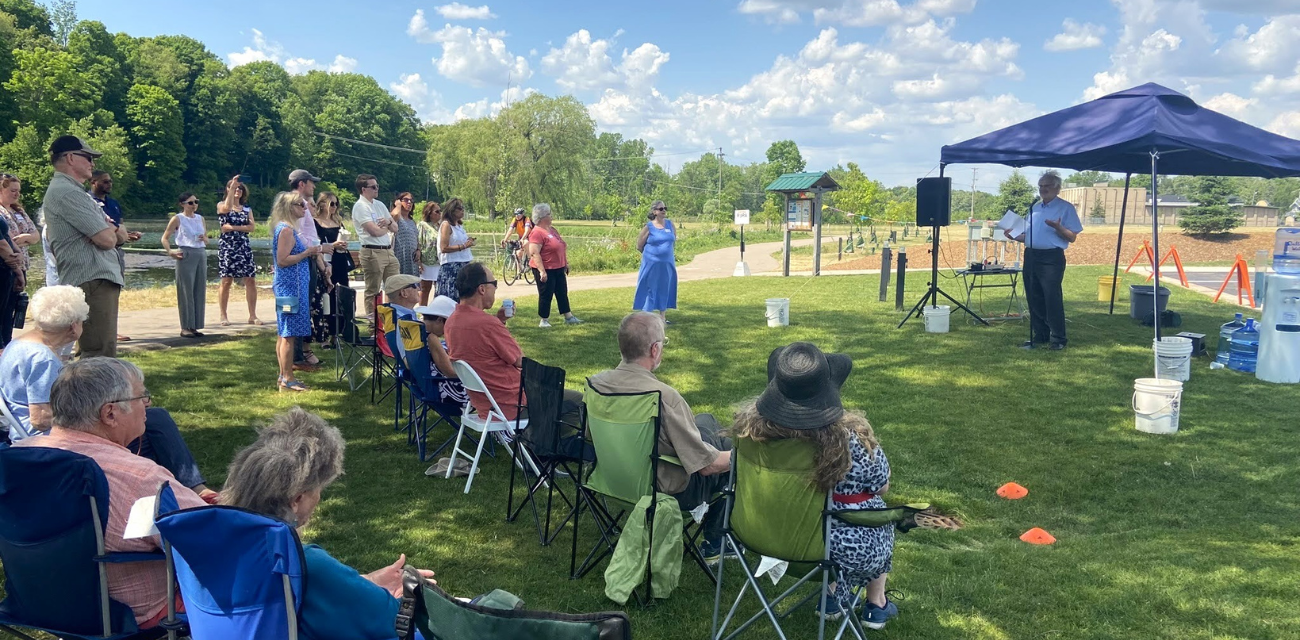PFAS-contaminated water in my backyard

Written by intern Travis McNamara
Growing up in a community like Rockford, Michigan, it’s easy to take a lot of things for granted. It felt safe and welcoming, and the idea that my family or neighbors could be drinking toxic water never crossed my mind. Then, one weekend while I was home from college, my Mom told me that I couldn’t drink from the tap, explaining why we had an unusually large amount of bottled water in the house.
She went on to inform me that Wolverine Worldwide, an American footwear company, had dump sites in the 1950s through the 1970s that weren’t properly taken care of, and that there might be a strange group of chemicals called PFAS (polyfluoroalkyl substances) in the water. My instant reaction was, “we’ve been drinking this water for 16 years and we are finding out about this now?!?” Luckily we were not directly in the area they currently believed to be toxic, but I was left feeling very angry and looking for someone to blame.
Time has allowed me to see the situation from a calmer perspective, but I am still feeling a mixture of frustration and confusion. Knowing I grew up swimming, kayaking and jumping into a contaminated river has been difficult to wrap my head around, but knowing that my friends and family living close to me have been exposed to these chemicals has been worse. It’s really strange for a small town like Rockford to be in any sort of spotlight and equally scary when you hear about a well in your area testing at 58,930 parts per trillion for PFAS when the EPA’s current recommended “safe” levels are 70 parts per trillion.
However, even this number may be too high. Like previously mentioned, PFAS are a group of chemical compounds which have not been researched well individually. But a recent draft study by the Center for Disease Control showed negative health impacts for certain PFAS compounds at significantly lower levels than the current EPA recommendation. The Association of Drinking Water Administrators expects the safe level to be lowered to between 7 to 11 parts per trillion for certain PFAS chemicals, ten times lower than the EPA’s current recommendation. The EPA says that Rockford has the highest concentration of PFAS in a well anywhere in the United States, at least so far. Even though the concentration in my town is especially high, there are 35 other Michigan communities where PFAS have been detected in the drinking water, and this number is expected to grow.
What may be most concerning in regards to PFAS is the lack of knowledge we currently have about these chemicals and how harmful they can be. Studies suggest that they may be linked to birth defects and cancer. What we do know about PFAS is that they are human-made, they travel long distances, and they can move through soil, groundwater and air. Recently, we also learned that the Michigan DEQ was warned about these dangerously high levels of PFAS back in 2012 in what is now being called the “Delaney Memo,” but did not take any action to try and stop these chemicals from seeping into our waterways or inform potentially affected communities. If this is sounding all too familiar to Michigan residents, it should be noted that the Flint crisis happened two years later.
Furthermore, recent reports show that a U.S. Department of Health and Human Services report which contained new information about the prevalence and dangers of PFAS was suppressed by the White House and EPA as a “public relations nightmare.” While Rockford’s experience may not be as extreme as it has been for those in Flint, both instances show an institutional failure in our state and federal agencies. This level of uncertainty and lack of transparency is extremely troubling, given that over 6 million people in America are believed to be drinking water contaminated with PFAS.
While the effects of PFAS on my community and others may never be fully known, I hope that at the very least we can take some lessons from this whole experience. Starting at the top, we need transparency of what has been dumped and where, and more frequent testing in public and private areas for toxic chemicals and metals. Most of all, I hope in the future that our state and federal agencies don’t repeat the mistake of delaying action, because the contamination isn’t going away by itself. I grew up jumping into the Rogue River without hesitation or a care in the world, and I hope the kids growing up in my neighborhood can one day do the same and be right to do so.
Discover
Power environmental change today.
Your gift to the Michigan Environmental Council is a powerful investment in the air we breathe, our water and the places we love.
Sign up for environmental news & stories.
"*" indicates required fields




